Fundada en 2011 por el diseñador japonés Shinya Hasegawa, Battenwear ha logrado posicionarse como una marca icónica que combina la nostalgia de las décadas de los 60 y 70 con una funcionalidad moderna. Inspirada en la cultura del surf y las actividades al aire libre, Battenwear celebra la conexión entre el estilo vintage y las necesidades prácticas de quienes buscan ropa versátil, resistente y con personalidad.
En esta entrevista con STAF Magazine, los Hasegawa revelan cómo su experiencia como diseñadores en Nueva York y su pasión por el surf dieron forma al ADN único de la marca. Su enfoque radica en crear prendas que sean cómodas tanto en entornos urbanos como en la naturaleza, con un diseño que rinde homenaje al espíritu aventurero de épocas pasadas. Desde chaquetas técnicas hasta mochilas y pantalones utilitarios, cada pieza está elaborada con materiales de alta calidad, priorizando la durabilidad y el detalle artesanal.
Battenwear no solo es ropa, es un estilo de vida para los exploradores modernos. Los diseños versátiles permiten a los usuarios moverse con libertad, ya sea caminando por la ciudad, surfeando en la costa o explorando senderos. Este equilibrio entre lo retro y lo contemporáneo ha conquistado a un público global que busca autenticidad y funcionalidad en su guardarropa.
Para los Hasegawa, Battenwear es un tributo al amor por los pequeños placeres de la vida al aire libre, uniendo lo mejor de ambos mundos: el diseño atemporal y las demandas de la moda actual. Si buscas prendas que cuenten historias, Battenwear es la elección perfecta. Y si quieres descubrir Battenwear, sumergete en esta entrevista y gozalo!
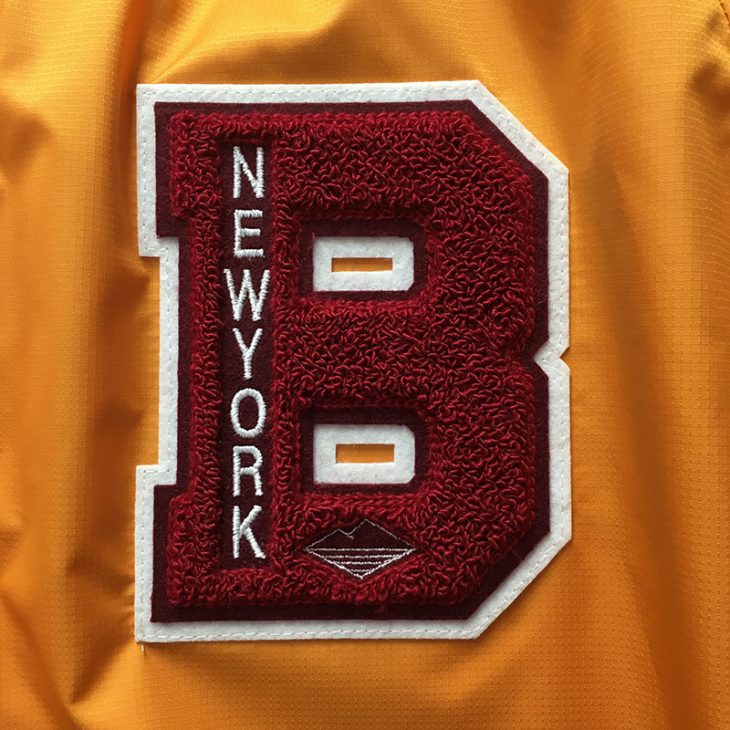
¿Cómo surge la creación de una marca como Battenwear y de dónde proviene el nombre? ¿Cuál es la historia detrás de ella, qué te inspiró, qué experiencias de vida te llevaron a crear Battenwear?
Battenwear surgió porque amamos la historia de la ropa deportiva y de outdoor en Estados Unidos, y queríamos poder usar ropa con una estética vintage específica pero con formas y telas contemporáneas. Nos gustaba la idea de resumir todos los mejores detalles (costuras, refuerzos, solapas, correas) de décadas de nuestra ropa favorita en cada prenda que hacíamos. Básicamente, queríamos hacer ropa simple, inteligente y cómoda, y esperábamos hacerlo de una manera que se sintiera diferente e interesante.
Para poneros en contexto, cuando comenzamos la marca a principios de la década de 2010, la ropa outdor aún se categorizaba principalmente como deportiva en lugar de lifestyle. Tuvimos la suerte de ser una de las primeras marcas en ese momento en reutilizar detalles de ropa de outdoor para la moda. Ahora nadie se sorprende al ver parkas de montaña combinadas con prendas más tradicionalmente elegantes. Básicamente, tuvimos buen timing, y hemos estado haciendo lo mismo y creciendo muy lentamente desde entonces.
De hecho, para esta entrevista, decidimos sacar a la luz nuestro primer comunicado de prensa, en el cual escribimos que Battenwear tiene como objetivo “identificar el punto de encuentro entre funciónal y moda. Motivado por la idea de una mochila perfectamente empacada, Shinya Hasegawa diseñó esta línea para el aventurero que necesita un equipo que funcione tan bien para un día de outdoor como para moverte en la ciudad. Creemos que la ropa debe poder desempeñar roles complementarios de comodidad y vanguardia en la moda, de simplicidad y atención al detalle”.
Eso es lo que seguimos buscando con cada nueva prenda que hacemos. El tipo de cumplido que más disfrutamos para la marca es cuando la gente se entusiasma con un bolsillo de la chaqueta o nos dice que han usado nuestros pantalones todos los días durante dos semanas seguidas o nos escriben para decir que les encanta llevar nuestras bolsas al mercado de agricultores y a la biblioteca cada sábado. Tenemos la suerte de que Battenwear se venda en tiendas divertidas y aparezca en revistas de lujo, pero lo más importante para nosotros es que Battenwear sea útil y cómodo, algo en lo que puedas confiar como en un viejo amigo.
“Battenwear” tiene sus raíces en un nombre de familia: cuando nos casamos, Carrie eligió usar el apellido de Shinya, Hasegawa. Y cuando empezamos la empresa, Shinya decidió usar el apellido de soltera de Carrie, Batten.
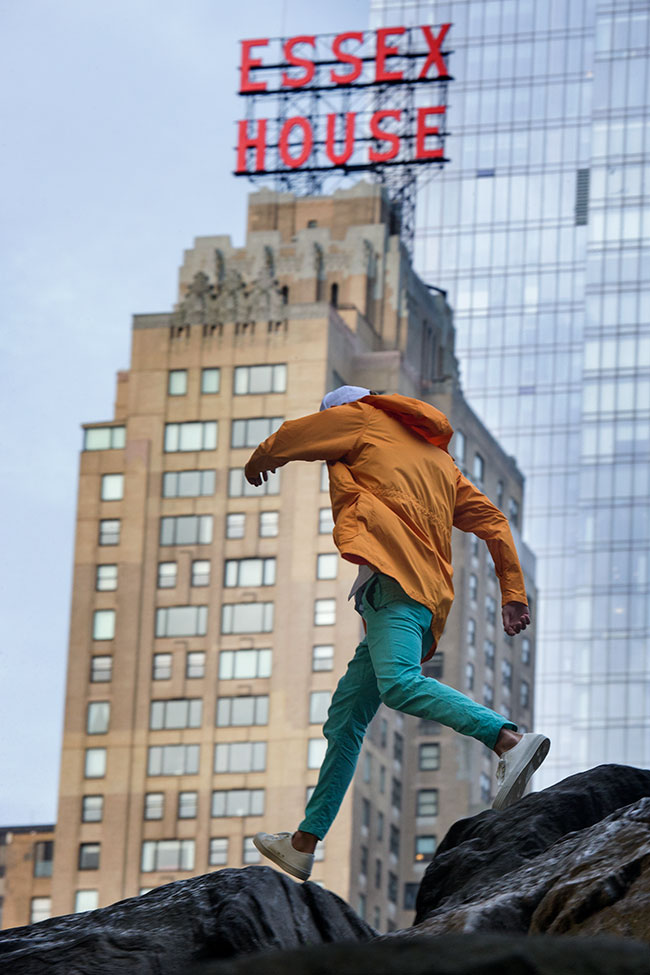
ph: Eric Kvatek
Mencionas que empezaste Battenwear con la intención de crear ropa que quisieras usar tú mismo. ¿Cuál fue el primer diseño que realmente te emocionó ver terminado y por qué?
La Travel Shell Parka fue el primer diseño de Shinya para Battenwear, y el modelo azul que ves aquí es la primera muestra que hicimos (también venía en naranja). Su idea era tener una chaqueta práctica que se pudiera usar en caminatas y en la naturaleza, pero que también se viera bien para una salida nocturna en la ciudad. Básicamente, no quería empacar varias chaquetas para viajar.
Y… una vez que se dio cuenta de que iba a viajar con ella, pensó que debería añadir muchos bolsillos interiores y exteriores para pasaportes, teléfonos, boletos y demás. La forma de la parka es ajustable mediante un cordón interior y una cremallera frontal de dos vías, por lo que se puede coordinar de diferentes maneras.
La TSP es nuestra chaqueta multifuncional y esperamos poder hacerla para siempre. Nos gusta imaginar que, en el futuro, alguien encontrará una Travel Shell Parka de la primera temporada hecha en Nueva York en alguna tienda vintage y se emocionará. (Consejo para los cazadores de tesoros: la etiqueta de esa temporada dirá “Batten Sportswear Brooklyn”). Tal vez sea un sueño raro, pero lo tenemos.
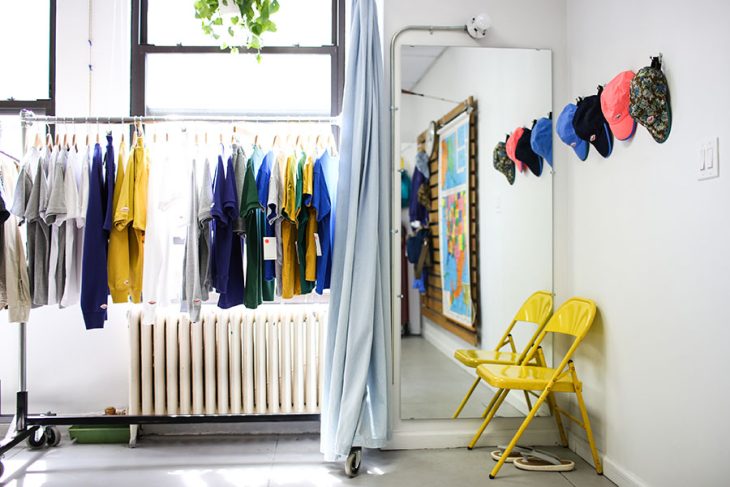
La filosofía de iniciar y dar vida a una marca de ropa se puede abordar de cien maneras diferentes, al igual que la vida misma. ¿Qué significa Battenwear para ti en tu vida cotidiana? ¿Crees en la filosofía de gestionar una marca como un estilo de vida? ¿En el romanticismo de hacer algo que es tu pasión y da sentido a tu vida?
Bromeamos diciendo que Battenwear es nuestro hijo mayor. Fundamos la empresa aproximadamente un año antes de que naciera nuestro hijo, y el parto de la marca fue más difícil que cualquiera de nuestros dos hijos. La marca siempre ha sido parte de nuestra familia: es la razón por la que podemos hacer cosas interesantes en todo el mundo, pero también es la razón por la que a veces debemos quedarnos en casa los fines de semana y estar frente a la computadora durante largas horas en lugar de salir a jugar. Queremos hacer las cosas bien y ofrecer un buen servicio al cliente, y ambas cosas requieren tiempo.
Ahora que nuestros dos hijos (y la marca) ya no son bebés, Battenwear se siente más como una mascota de la que toda la familia cuida. A nuestros hijos y a sus amigos les encanta pasar el rato en nuestra oficina de diseño y en los eventos de trabajo. Nos ayudan a crear contenido para nuestra página web y a contar los materiales para la producción. Un par de veces, nuestra mesa del comedor en casa se ha convertido en un espacio de almacén con abuelos y niños poniendo etiquetas y bolsas en los sombreros.
Nuestro vecindario en Los Ángeles también se ha convertido en un grupo de apoyo para Battenwear. Tenemos grandes amigos que viven en nuestra calle y que trabajan como estilistas y en la industria del cine/televisión. Todos prueban nuevos artículos para nosotros y nos ayudan con ideas y proyectos.
Nos sentimos afortunados de tener un trabajo que es parte de lo que somos. Es un inmenso privilegio y, en su mayoría, una alegría poder construir una marca y una filosofía de marca, y luego ver cómo se desarrolla de manera tan hermosa a tu alrededor. “Pasión” y “romanticismo” son palabras correctas para describir la búsqueda de tu vida, pero generalmente solo se siente como “trabajo duro” y “demasiado ocupado”. Tener amigos y familia con nosotros hace que el trabajo sea mucho más significativo.

Comenzaste en el Garment District de Nueva York, un barrio famoso por su historia en la fabricación de ropa. ¿Cómo ha sido tu experiencia trabajando con fabricantes locales y qué desafíos has enfrentado, tanto en tus primeros días como ahora?
Durante los primeros cinco años o más, casi toda la producción de Battenwear se hacía en un radio de tres manzanas desde nuestra oficina en el Garment District de Manhattan. Teníamos un mapa del tesoro súper local de socios comerciales, ubicados entre nuestras cafeterías y restaurantes de ramen favoritos: proveedores de telas, tiendas de adornos, nuestro creador de patrones, cortadores, los viejos que dirigían la imprenta de camisetas… Pasábamos mucho tiempo subiendo en ascensores y rodando carritos y cajas por Manhattan, y fue genial. Muchos de nuestros amigos tenían sus propias marcas en el vecindario, y siempre había fiestas, lanzamientos y eventos creativos. No podríamos haber pedido un mejor laboratorio para crear los primeros años de Battenwear.
Por supuesto, todo lo bueno llega a su fin, y para nosotros fue un tema de costos. Con la expansión de la escena de los condominios en Manhattan hacia el Garment District, los alquileres subieron y muchos de nuestros socios locales se mudaron. Eventualmente, nosotros también tuvimos que mudarnos. Decidimos dar un gran salto hasta Los Ángeles, donde Carrie había crecido.
El mayor choque cultural resultó ser lo diferente que era el proceso de fabricación de ropa en la costa oeste. Siempre hemos pensado que las personas y el entorno donde se fabrica la ropa son tan importantes como las máquinas o los materiales, por lo que tratamos de conocer a nuestros costureros y ajustar nuestros diseños a sus fortalezas.
Puede parecer un ejemplo menor de las diferencias entre la costa este y la oeste, pero en Manhattan, los costureros suelen sentarse en cuadrados para compartir herramientas de manera eficiente mientras trabajan. Cuando llegamos, éramos solo otro elemento del ruido y el caos general, y era fácil observar y aprender. Podíamos sentarnos con los costureros y doblar la tela juntos para encontrar soluciones a mejores puños y costuras.
En cambio, en Los Ángeles, la mayoría de las fábricas tienen estaciones separadas que miran en la misma dirección, como pupitres de clase. Es igualmente eficiente, pero de manera diferente.

Al mudarnos a Los Ángeles, intentamos pasar tanto tiempo en nuestras nuevas fábricas como lo habíamos hecho en las anteriores para acostumbrarnos a los nuevos ritmos, pero la ciudad está muy extendida. En Manhattan, podíamos visitar todas nuestras fábricas antes de almorzar y aún tener tiempo para sentarnos, diseñar y tener reuniones. En Los Ángeles, tal vez podíamos visitar dos fábricas si pasábamos todo el día conduciendo y volvíamos sudados por el tráfico.
Luego, todo cambió una vez más durante la pandemia. Nadie estaba entrando en las fábricas para charlar. Algunos días, solo había un par de costureros, o dependían de personal completamente nuevo que llegaba a última hora. Muchas de nuestras fábricas cerraron o comenzaron una larga caída que llevó a que cerraran más tarde o aumentaran drásticamente sus mínimos.
De todos modos, durante ese periodo tuvimos que comenzar a hacer más de lo que Shinya describe como “diseño imaginario”, haciendo algunos de nuestros artículos de manera remota en Japón. Somos de muy baja tecnología, y todavía usamos dibujos a mano y descripciones en lugar de paquetes técnicos generados por computadora. Afortunadamente, tenemos algunos socios excelentes en Japón, y la comunicación fue fluida y fácil.
Nuestros diseños imaginarios pronto se convirtieron en artículos reales en nuestras manos. Nunca habíamos imaginado realmente hacer Battenwear principalmente en Japón, ya que es una estética inspirada en América, pero ha resultado tener mucho sentido. Obtenemos lo mejor de ambos mundos: precisión y calidad japonesa con ingenio y estilo estadounidense.
Ahora nos estamos preparando para trasladar todo a Japón el próximo año: nuestra familia, la oficina de diseño, etc. Así que estad pendiente porque estoy seguro de que pronto tendremos más cosas que contar.
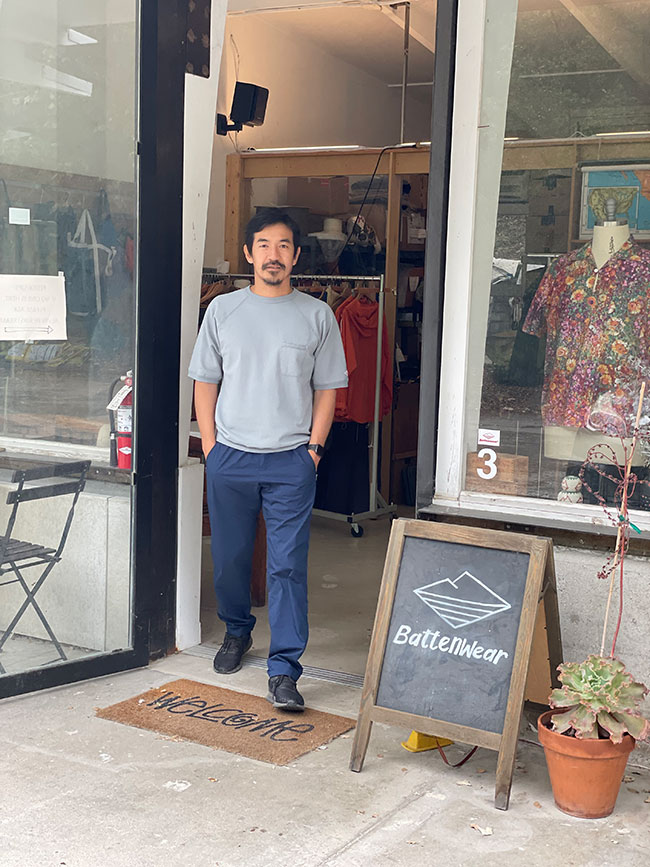
La década de 1960 a la de 1990 es una era y cultura inspiradora para ti. ¿Puedes contarnos sobre esa época, por qué la cultura outdoor estadounidense de esas décadas pasadas, y ese estilo de vida, es tan emocionante?
Para nosotros, la cultura outdoor estadounidense durante ese período es un testimonio de la solución creativa de problemas. Había tantos cambios ocurriendo en el mundo y en la cultura popular en ese momento, y la gente se sentía muy libre para crear cosas que no se ajustaban a las expectativas del pasado. Todo estaba cambiando y era dinámico. Al mismo tiempo, las personas estaban explorando el mundo natural que rodeaba las grandes ciudades en todo el planeta. Querían ponerse a prueba frente a la naturaleza y querían inventar ropa y equipo para ayudarles. Hay algo muy genial en prepararse para lo desconocido.
Tenemos muchos libros de fotos de los primeros escaladores, surfistas y excursionistas. Abrieron nuevos caminos no solo en el logro físico humano, sino también en la moda y el estilo. De manera similar, nos gusta coleccionar viejos catálogos de Patagonia y Banana Republic que se centraban en la utilidad de su ropa en entornos naturales.
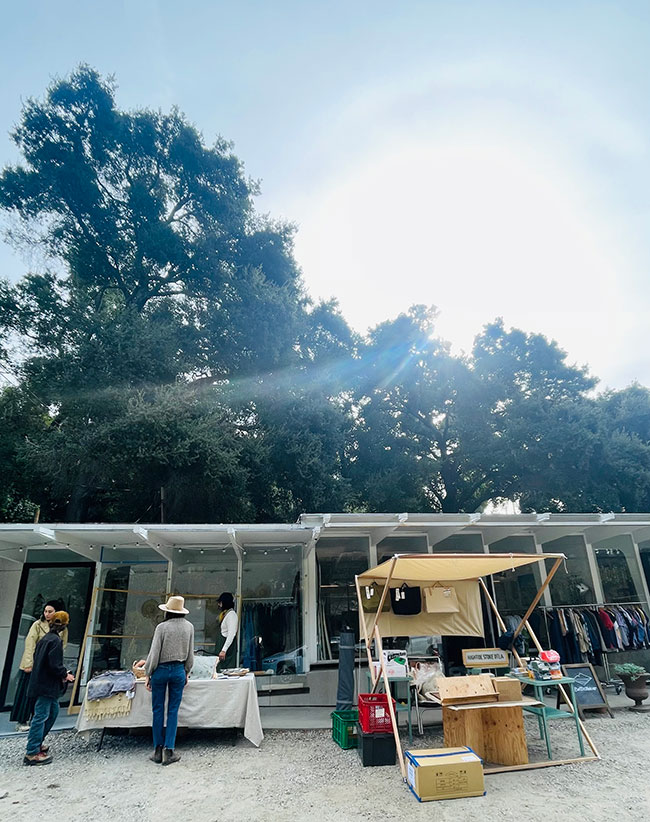
Hablas sobre la importancia de que las prendas mejoren con el uso y el tiempo. Y, por ejemplo, comparas la visión de Battenwear con los discos de vinilo, algo para atesorar y pasar a la siguiente generación. ¿Puedes explicar cómo diseñas específicamente para esa durabilidad, sostenibilidad y evolución en tus productos?
No hay forma de detener el mundo digital, pero nos tocó crecer en una época analógica y somos personas lentas, no tecnológicas. Tratamos de no ser demasiado pretenciosos al respecto, pero preferimos que nuestro arte, música y herramientas sean objetos físicos, creados e inherentemente imperfectos por manos humanas. Nos encantan las indicaciones de un diseño pensado: cuando puedes ver que la persona detrás del objeto dedicó tiempo a hacerlo lo mejor posible. Nos encanta aún más cuando esa persona descubrió cómo lograr la perfección de una manera inesperada o sorprendente. Todo se trata de ingenio humano para nosotros.
Para la ropa, que se usa y se lava repetidamente, una forma de ser ingenioso es elegir telas, hilos y técnicas de costura que estén específicamente pensados para envejecer bien con el proceso de uso y lavado. Hacemos muchas pruebas y estudiamos piezas vintage para llegar a las fórmulas adecuadas.
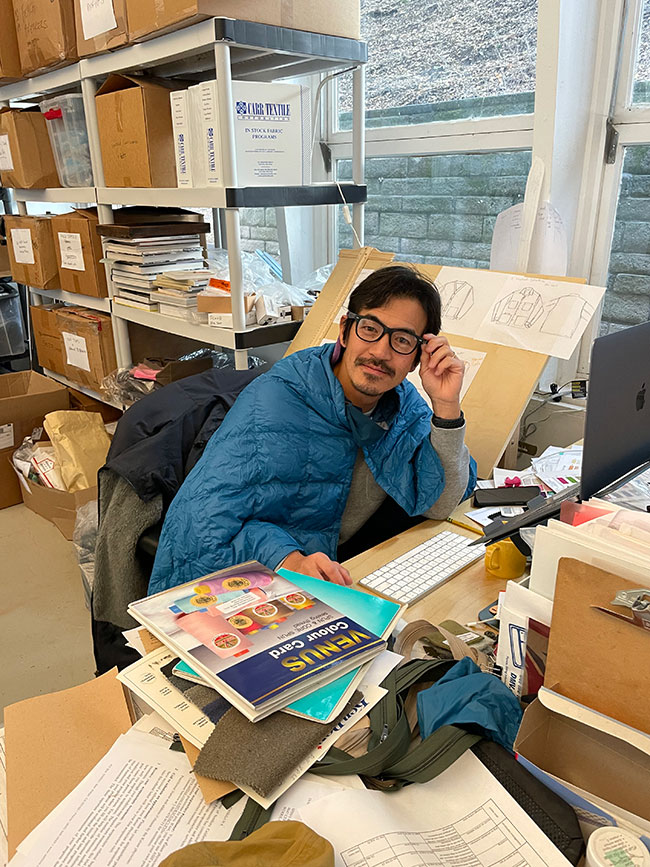
¿Cómo crees que tu mudanza a Topanga Canyon ha cambiado tu perspectiva sobre tus procesos creativos y decisiones de diseño en comparación con tu base anterior en Nueva York?
Nuestra oficina en Manhattan estaba en la misma calle que una estación de bomberos importante y a solo unas cuadras de Times Square. Siempre era ruidoso, y sucedían muchas cosas extrañas, como cuando una tapa de alcantarilla explotó a una cuadra de distancia y arrojó fuego durante media hora. Había reportajes frecuentes sobre la plaga de ratas en el Dunkin Donuts de la esquina y redadas de drogas en el McDonald’s de la calle. Era caótico, y nos encantaba.
Nuestra oficina en Topanga está junto a un arroyo que se llena de ranas cantando cuando llueve. A veces, los ciervos vagan y roban tomates de las plantas que crecen en nuestro estacionamiento. Podemos cruzar la calle y caminar por la colina hacia un parque estatal con vistas al océano. Podemos subirnos al coche y estar en la playa para surfear en 15 minutos. Es pacífico, y nos encanta.
Ambos han sido lugares maravillosos para nosotros, pero Nueva York era definitivamente más propicio para el diseño. El viaje en metro por la mañana y las multitudes en la calle siempre fueron una inspiración para nuestras elecciones de colores y telas. La vibrante vida cotidiana nos mantenía activos y creativos todo el tiempo. Siempre teníamos una audiencia para nuestras ideas.
En Topanga, el ritmo es mucho más lento y la gente es menos y más distante. Sin embargo, la contrapartida es que estamos rodeados de una naturaleza hermosa, lo cual es inspirador y vigorizante de una manera diferente.
Estamos ansiosos por ver cómo será nuestro nuevo espacio en Tokio y cómo afectará lo que hacemos.
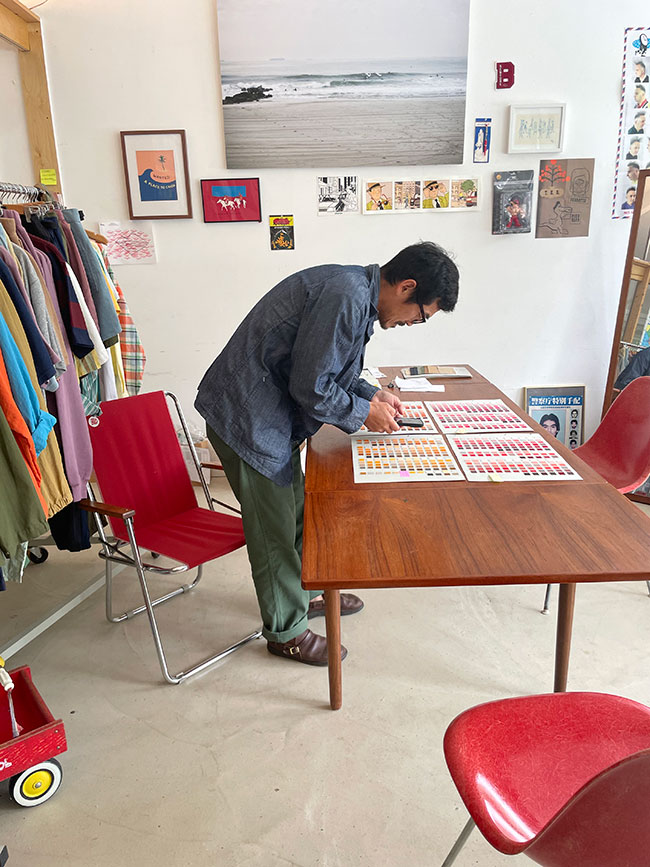
Mencionas que el color es lo primero que consideras al diseñar. ¿Puedes describir cómo seleccionas una paleta de colores para una nueva colección?
Nos gusta tener hilos visuales y temáticos que conecten los elementos de cada colección. El color de las telas y los estampados/patrones son el primer hilo que trabajamos, porque es la forma más eficaz de atraer y mantener la atención.
En cuanto a qué color o patrón elegir, intentamos prever lo que será tendencia, pero más importante aún, nos enfocamos en algo que nos haya inspirado recientemente. Por ejemplo, para nuestra colección primavera/verano 2024, nos inspiramos en el libro “75-85 Surfing Japan”, que es una compilación de fotos de revistas de surf de Japón. El libro tiene colores y patrones muy vivos, con un fondo de océano azul brillante y cabañas de playa arenosas. Todo el mundo tiene bigotes, un bronceado espectacular y parece que pueden dominar la pista de baile. Para esa temporada, nos centramos en la imagen mental de los surfistas japoneses de antaño (como cuando una canción se te queda en la cabeza) y seleccionamos los colores y patrones en consecuencia.
Para nuestra próxima colección de invierno FW24, nos inspiramos en álbumes de fotos de acampadas en coche con nuestras familias y amigos en los años 80 y 90. Ya sea en Japón (Shinya) o California (Carrie), había un estilo similar en esas fotos: chaquetas acolchadas, telas sintéticas en colores desgastados, tiendas de campaña elegantes y neveras de plástico. Fue muy divertido trabajar con ese ambiente al elegir las telas y los acabados.
Cuando empezamos la marca, estábamos tan comprometidos con la idea de tener un tema cohesivo para cada colección que escribíamos una historia breve para incluirla al inicio de cada catálogo estacional. Inventábamos un personaje y una situación con un arco narrativo rápido para preparar el escenario antes de que los compradores vieran la colección. No sabemos cuántas personas realmente leían las historias, pero fue una técnica divertida para plasmar nuestras ideas de la temporada.

La experiencia del usuario se ha convertido en una herramienta poderosa para promover una marca. Hoy, al elegir qué productos o servicios consumir, parece que expresamos nuestro apoyo o rechazo a las empresas. ¿Crees que el consumidor tiene más influencia de la que percibe?
Cuando pensamos en por qué Battenwear es valiosa como marca, nuestros clientes siempre están en primer lugar. Tenemos mucha suerte de contar con clientes comprometidos, apasionados, divertidos y amables. Por supuesto, también hay personas a las que no les gustamos o que solo quieren quejarse, pero hemos tenido muchas más que nos han dicho que conectan con Battenwear a nivel artístico, nostálgico o de calidad. A través de conversaciones por correo electrónico o mensajes directos, hemos conocido a personas interesantes de todo el mundo. Lo disfrutamos muchísimo. Más importante aún, vemos cómo nuestros clientes se conectan entre sí en redes sociales, elogiándose por sus atuendos o recomendando artículos a amigos. Es maravilloso ser parte de esta comunidad.
Así que sí, estamos 100% de acuerdo en que el consumidor tiene una influencia significativa en nosotros, probablemente más de la que sabe. Sin el apoyo de nuestros clientes durante estos años, habríamos dejado de hacerlo hace tiempo y simplemente haríamos ropa genial para nosotros mismos y buscaríamos otro trabajo.
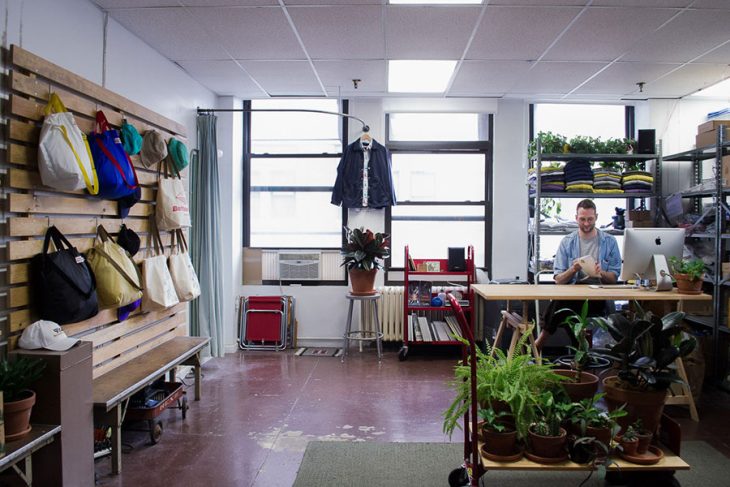
Has trabajado con Daiki Suzuki y Takeshi Ohfuchi en colaboraciones para Battenwear. Cuéntanos sobre su trabajo, ya que en España no son muy conocidos. ¿Qué aprendizajes y perspectivas obtuviste de estas colaboraciones que impactaron tu trabajo futuro en Battenwear?
Daiki Suzuki es el diseñador de Engineered Garments, pero a principios de los 2000 también diseñó para el proyecto Woolrich Woolen Mills, encargado por la empresa italiana WP Lavori en colaboración con los históricos molinos de lana Woolrich en Pensilvania. Daiki eligió a Shinya como su asistente de diseño para este proyecto, no por su experiencia en diseño (de la cual Shinya casi no tenía), sino por su conocimiento de ropa deportiva y de exterior vintage estadounidense. Así, Shinya pasó cuatro años aprendiendo diseño de Daiki, ¡como un master universitario de cuatro años!
Takeshi Ohfuchi es el diseñador de Post O’Alls y amigo desde hace más de 20 años. Shinya nunca diseñó con él en Nueva York, pero pasábamos mucho tiempo juntos y aprendimos mucho al observarlo y conversar con él. Es un maestro del enfoque profundo: sus diseños están muy bien investigados y creados con detalle. Gran parte de lo que hacemos en Battenwear lleva su influencia.
Hicimos colaboraciones con Engineered Garments y Post O’Alls para el 10º aniversario de Battenwear. Fue un honor inmenso trabajar con cada diseñador para esta ocasión especial. Nos regalaron su conocimiento y experiencia, y ese orgullo que sentimos al recibirlo es una gran motivación para los próximos 10 años.

Mientras hay una gran tendencia hoy en día de llevar tecnología ultramoderna a las marcas de outdoor y deportes, vosotros habéis optado por materiales duraderos en lugar de tejidos técnicos ultramodernos. ¿Podrías explicar más sobre esta elección y cómo ves el equilibrio entre la tecnología avanzada y las técnicas tradicionales de confección en la moda outdoor actual?
Nos encanta la ropa y los equipos outdoor de alta tecnología. Muchas marcas están haciendo cosas emocionantes, y el estilo es muy atractivo y moderno. Definitivamente nos sentimos tentados por algunos de ellos.
Sin embargo, aunque creemos que hay un lugar para lo ultramoderno y/o lo de alta tecnología en la moda, no es lo que nos interesa personalmente hacer. Lo “ultramoderno” tiene un período de vigencia corto: no pasa mucho tiempo antes de que parezca desactualizado. Queremos que sigas usando tu Battenwear hasta que esté completamente desgastado… o que lo pases como herencia si creces y ya no te queda bien.
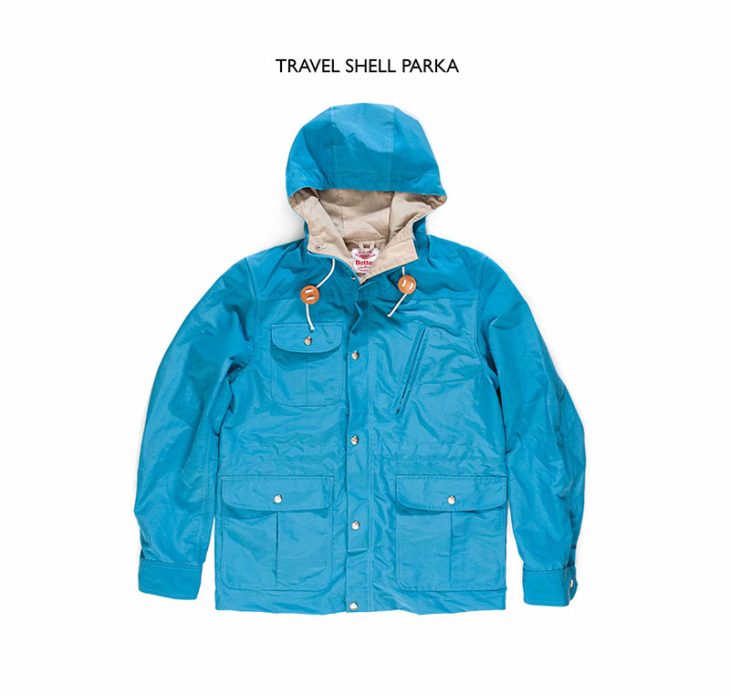
En términos de sostenibilidad, ¿qué prácticas implementa Battenwear para garantizar una producción responsable con el medio ambiente? ¿Y qué opinas de las campañas de marketing de las grandes marcas que promueven la sostenibilidad pero, al final, no son tan sostenibles?
Creemos que lo mejor que puede hacer una empresa de nuestro tamaño por el medio ambiente es crear ropa que sea menos propensa a terminar en vertederos. Sí, nos gusta la idea de usar tejidos reciclados, pero el objetivo final debe ser que las personas compren menos cosas y desechen menos cosas. Convertir basura en ropa es genial, siempre y cuando no vuelva a convertirse en basura casi de inmediato. Intentamos hacer prendas que nuestros clientes amen y no quieran desperdiciar.
En cuanto a tu segunda pregunta, el marketing es marketing, y todo es válido en el amor y la guerra, pero es un poco desagradable cuando las marcas intentan ganar dinero explotando la ansiedad de los clientes sobre el medio ambiente.
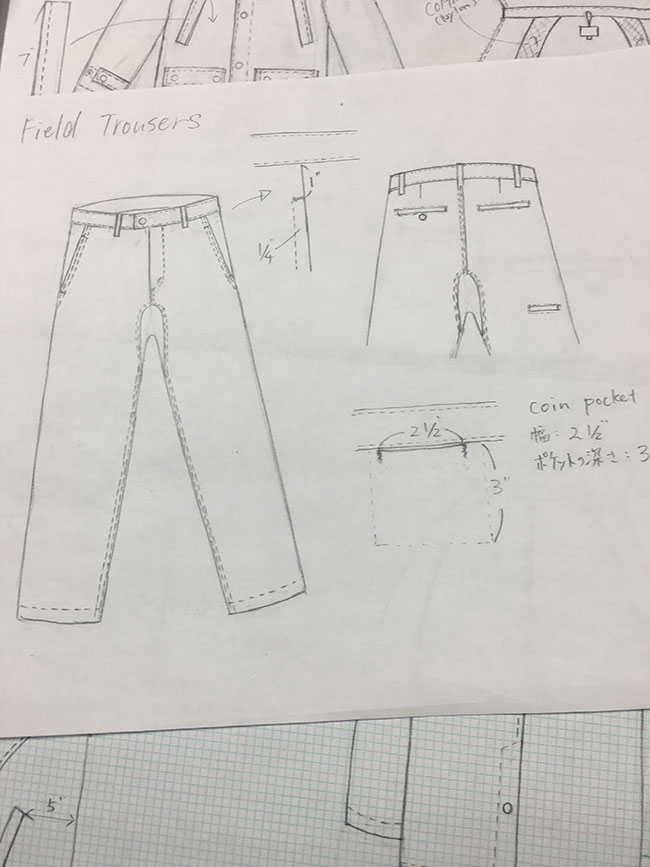
En general… ¿Cómo ves el mundo de la moda hoy en día, con grandes marcas, pequeñas marcas, tiendas online, tiendas físicas, mercados callejeros, segunda mano… y una producción prácticamente infinita? ¿Cómo crees que todo esto puede sostenerse con el tiempo y cómo crees que afectará al mundo en el que vivimos?
¡Es una gran pregunta! En lo que a nosotros respecta, estamos viviendo un momento de cambio decisivo en la industria de la moda. Uno de los mayores catalizadores de este cambio es internet y las redes sociales. La forma en que las personas fabrican, venden, anuncian y compran ropa ha cambiado drásticamente en las últimas décadas, y el cambio parece estar acelerándose ahora mismo. Nunca antes las marcas habían tenido la capacidad de llegar directamente a personas de todo el mundo. Ha sido una verdadera explosión de tendencias nicho.
La moda rápida es solo uno de muchos vicios humanos insostenibles, y no está haciendo nada bueno por el planeta.
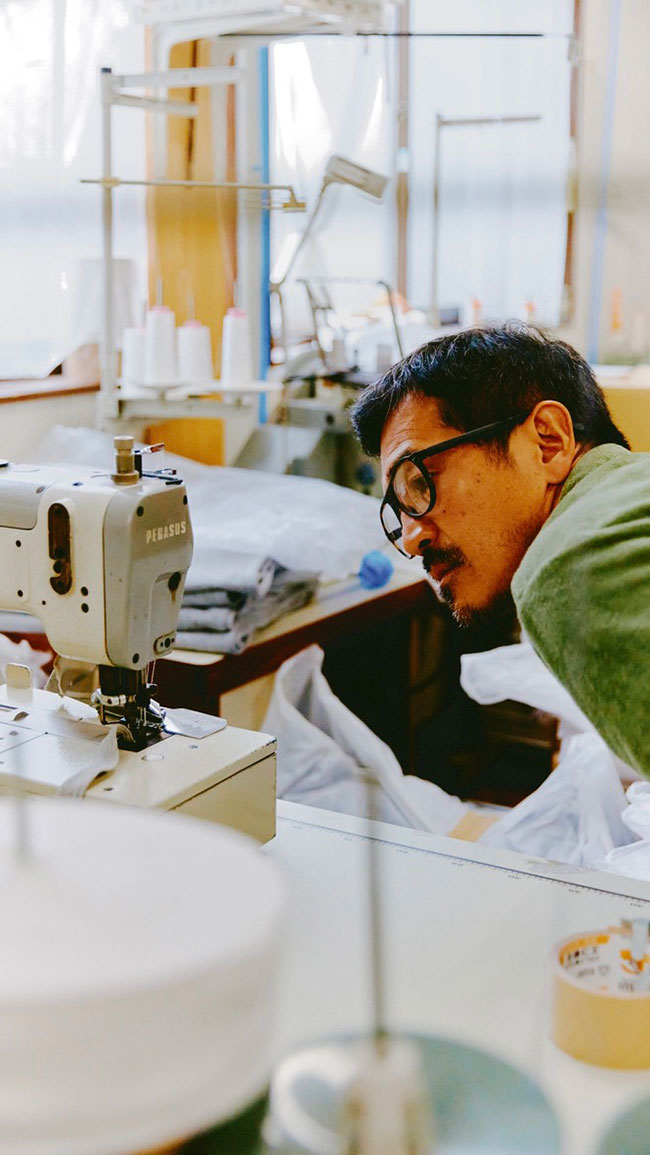
¿Y Europa y Battenwear? ¿Es Europa un lugar que os inspira? ¿Cómo esperáis que influya en el futuro de Battenwear?
¡Sí! Nuestro primer mercado importante fue el Reino Unido, pero nunca hemos tenido una representación amplia en toda Europa. Dado que no tenemos oficina ni distribuidor en Europa, no podemos importar productos directamente allí y dependemos de que las tiendas lo hagan desde nuestro almacén en EE. UU. Esto no es algo que muchas tiendas estén dispuestas a hacer, y puede ser costoso. Sin embargo, muchas otras marcas han encontrado soluciones, así que estoy seguro de que, una vez que crezcamos un poco más, nosotros también lo haremos. Crucemos los dedos, porque siempre ha sido un objetivo nuestro tener mayor alcance en Europa.
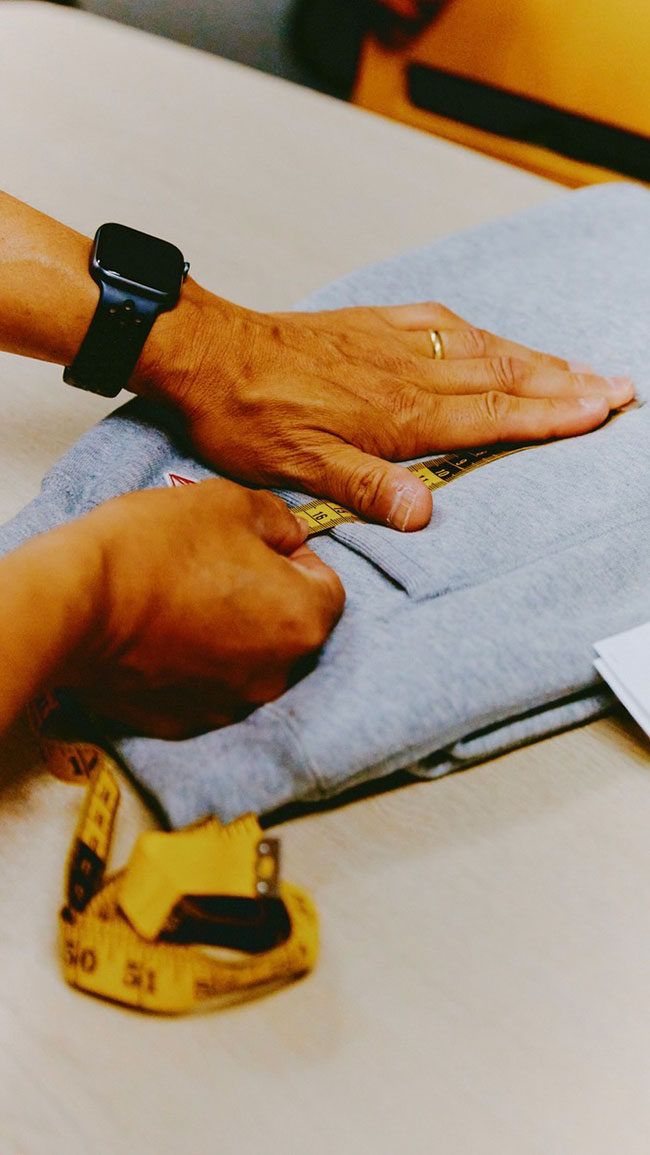
Cuéntanos sobre la historia de los Local Shorts. ¿Qué te inspiró específicamente de los pantalones cortos Ocean Pacific de los años 70 para crear los Local Shorts de Battenwear?
Comenzamos a hacer los Local Shorts en 2013 porque nos encantaban los pantalones cortos de skate de pana de Ocean Pacific, y queríamos crear una versión para el uso diario. Pasamos las primeras temporadas probando diferentes largos, formas y detalles para los shorts, y eventualmente encontramos la versión que nos encanta a nosotros y a todos nuestros amigos. La gente se enfadaría si seguimos cambiándolos.
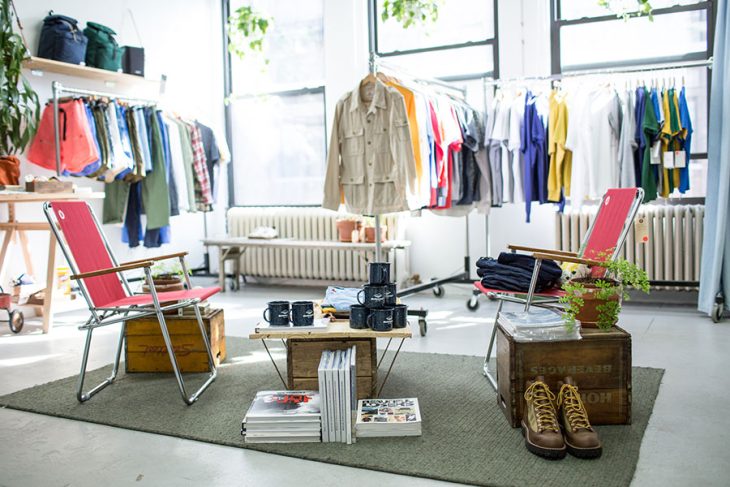
Y para terminar, ¿Puedes hablarnos de los 11 pasos para crear los Local Shorts y cómo han evolucionado?
Para ofrecer a nuestros clientes una idea de nuestro proceso de diseño, dividimos la producción de los Local Shorts en 11 pasos en el Journal de nuestro sitio web. Aquí hay un resumen:
- Dibujar a mano la prenda.
- Elegir la tela según la paleta de colores de la colección.
- Investigar y seleccionar accesorios.
- Anotar y editar con cinta adhesiva piezas vintage como referencia para el patronista.
- Crear el patrón.
- Hacer una muestra, corregir problemas, hacer otra muestra, repetir según sea necesario.
- Fotografiar planos y con modelos, mostrar las muestras finales a los socios y tomar pedidos.
- Calcular el metraje de tela y la cantidad de accesorios necesarios.
- Reservar espacio en la fábrica y actuar como enlace con los proveedores.
- Producción en la fábrica.
- Control de calidad, doblado, etiquetado, embolsado y etiquetado de cada prenda.
www.battenwear.com
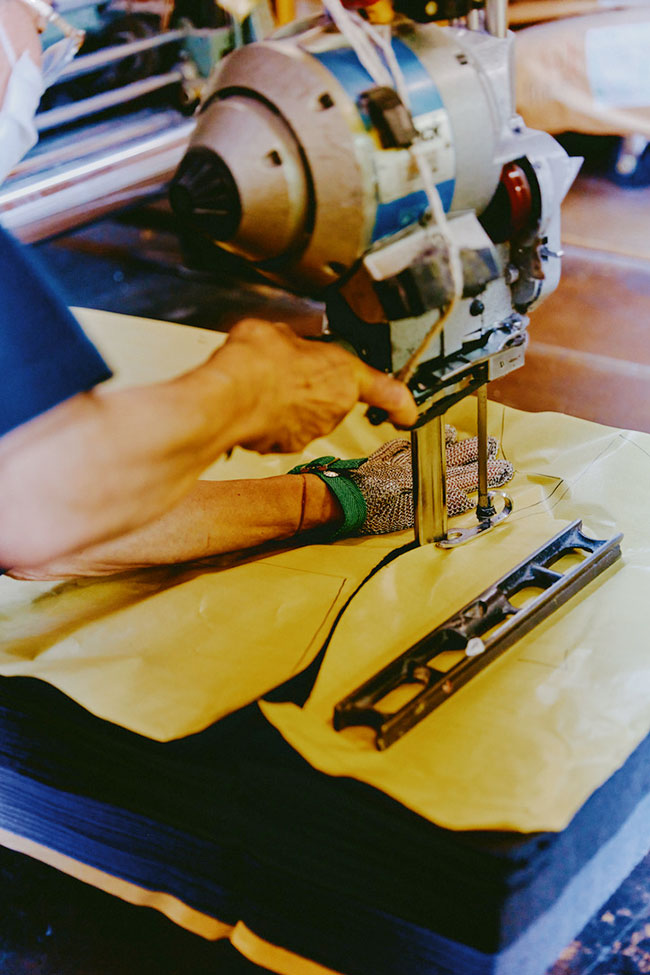
English:
Battenwear
Exploring Functional Aesthetics: A Conversation with Shinya & Carrie Hasegawa, Founders of Battenwear.
Founded in 2011 by Japanese designer Shinya Hasegawa, Battenwear has positioned itself as an iconic brand that combines the nostalgia of the 60s and 70s with modern functionality. Inspired by the culture of surfing and outdoor activities, Battenwear celebrates the connection between vintage style and the practical needs of those seeking versatile, durable clothing with personality.
In this interview with STAF Magazine, the Hasegawa’s reveal how their experience as designers in New York and their passion for surfing shaped the brand’s unique DNA. Their focus lies in creating garments that are comfortable in both urban and wilderness environments, with design that pays homage to the adventurous spirit of bygone eras. From technical jackets to backpacks and utility pants, each piece is made with high quality materials, prioritizing durability and handcrafted detail.
Battenwear isn’t just clothing, it’s a lifestyle for modern explorers. Versatile designs allow wearers to move freely, whether walking around town, surfing the coast or exploring trails. This balance of retro and contemporary has won over a global audience looking for authenticity and functionality in their closet.
For the Hasegawa’s, Battenwear is a tribute to the love of the small pleasures of outdoor living, bringing together the best of both worlds: timeless design and the demands of fashionable performance.
How does the creation of a brand like Battenwear come about and where does the name come from? What is the story behind it, what is the vision, what inspired you, what life experiences led you to create Battenwear?
Battenwear began because we love the history of American outdoor- and sports- gear, and we wanted to be able to wear clothing that had a specific vintage aesthetic but in contemporary shapes and fabrics. We liked the idea of summarizing all the best details (seams, gussets, flaps, straps) from across decades of our favorite gear in each item we made. We basically wanted to make simple, smart, comfortable clothes, and we were hoping to do it in a way that felt different and interesting.
For context, when we started the brand in the early 2010s, outdoor clothing was still mostly categorized as gear rather than lifestyle. We were lucky to be among the first few brands at the time to repurpose outdoor details for fashion. Now no one is surprised to see mountain parkas mixed with more traditionally stylish items. Basically, we had a case of good timing, and we’ve been doing the same thing and very slowly growing ever since.
Actually, for the purpose of this interview, we decided to dig out our first press release, in which we wrote that Battenwear aims to “pinpoint the intersection between function and fashion. Motivated by the idea of a perfectly packed bag, Shinya Hasegawa designed this line for the adventurer who needs gear that works equally well for an action-filled day outdoors as for a gathering in the city. We believe clothes should be able to fill complementary roles of comfort and cutting-edge fashion, of simplicity and careful detailing.”
That is still what we strive for with each new item we make. The kind of compliment we enjoy most for the brand is when people nerd out about a jacket pocket or tell us they wore our pants every day for two weeks straight or write to say they love to take our totes to the farmer’s market and library each Saturday. We are lucky Battenwear is sold at fun stores and featured in glossy magazines, but it’s most important to us that Battenwear be useful and comfortable–something you can count on like an old friend.
“Battenwear” has its roots in a family name—when we married, Carrie chose to use Shinya’s last name, Hasegawa. And when we started the company, Shinya chose to use Carrie’s maiden name, Batten.
You mention that you started Battenwear with the intention of creating clothes that you wanted to wear yourself, what was the first design that you were really excited to see finished and why?
The Travel Shell Parka was Shinya’s first design for Battenwear, and the blue one here is first sample that we made (it also came in orange). His idea was to have a practical jacket that could be worn on hikes and in nature, but that also looked good for an evening out in town. Basically, he wanted not to pack multiple jackets for travel.
And . . . once he realized that he was going to be traveling in it, he figured he should add a bunch of inner and outer pockets for passports and phones and tickets and everything. The parka’s shape is adjustable via inner drawstring and 2-way front zipper, so you can coordinate in different ways.
The TSP is our Jacket-of-all-trades and we hope to be able to make it forever. We like to imagine that in the future, someone will find that first season made in NYC Travel Shell Parka in a vintage shop somewhere and be excited. (Hint to loot diggers: the label that season will say “Batten Sportswear Brooklyn”) Maybe that’s a weird dream to have.
The philosophy of starting and bringing a clothing brand to life can be approached in a hundred different ways, just like life itself. What is Battenwear for you in your life, in your day-to-day? do you believe in the philosophy of running a brand as a way of life? in the romanticism of doing something that is your passion and gives meaning to your life?
We joke that Battenwear is our oldest child. We founded the company about a year before our son was born, and the brand’s labor and delivery into the world was even harder than either of our human kids. The brand has always been a part of our family—it’s the reason we get to do interesting things all over the world, but it’s also the reason why we must stay home on weekends sometimes and be in front of the computer long hours instead of playing. We want to make good things and be good at customer service, and both of those things take time.
Now that our two kids (and the brand) are no longer babies, Battenwear feels more like a pet that the whole family takes care of. Our kids and their friends love to hang out at our design office and work events. They help us make content for our website and count trim for production. A couple of times, our dining room table at home has become a warehouse workspace with grandparents and kids applying hangtags and bags to hats.
Our neighborhood in Los Angeles has become a Battenwear support group too. We have great friends living on our street who are stylists and film/tv people. They all test new items out for us and brainstorm/help us on projects.
We feel lucky to have a job that is so much a part of who we are. It is an immense privilege and mostly a joy to be able to build a brand and a brand philosophy and then to be able to see it play out so beautifully all around you. “Passion” and “romance” are correct words to use for one’s life pursuit, but it usually just feels “hard” and “too busy.” Having friends and family with us makes the work a lot more meaningful.
You started in the Garment District in New York and that neighborhood is famous for its history of clothing manufacturing. What has your experience been like working with local manufacturers and what challenges have you faced, both in your early days and today?
For the first five years or so, we made almost all Battenwear in a three-block radius of our office in Manhattan’s Garment District. We had a super local treasure map of business partners tucked in between our favorite neighborhood coffee shops and ramen restaurants: fabric suppliers, trim stores, our pattern maker, grader, cutting room, the old men who ran the tee shirt printer. . . We spent lots of time riding in elevators and rolling carts and boxes around Manhattan, and it was great. Lots of our friends had their own brands in the neighborhood, and there were always parties and launches and creative events. We could not have asked for a better laboratory to make the first several years of Battenwear.
Of course, all good things must come to an end, and for us it was a cost issue. With Manhattan’s condo scene expanding into the garment district, rents were rising and a lot of our local partners moved out. Eventually we needed to move too. We decided to take a big leap all the way out to Los Angeles where Carrie had grown up.
The biggest culture shock turned out to be how different the process of making clothes was on the west coast. We have always thought that the people and environment where clothing is made is just as important as the machines or materials, which is why we try to get to know our sewers and adjust our designs to their strengths.
This may seem like a minor example of east coast/west coast differences but in Manhattan, sewers tend to sit in squares so that they can share tools efficiently while they work. When we walk in, we are just another piece of the overall noise and chaos, and it’s easy to watch and learn. We could sit together with our sewers and bend and fold the fabric to figure out solutions to better cuffs and seams.
Meanwhile, In Los Angeles, most clothing factories have separate stations all facing the same direction, like classroom desks. It’s equally efficient but just in different way.
Upon moving out to LA, we tried to spend as much time in our new factories as we had in our old, so that we could get used to the new rhythms, but the city is so spread out. In Manhattan, we could visit each of our factories before lunch and still have time to sit and design and have meetings. In Los Angeles, we could maybe visit two factories if we spent all day driving and got home sweaty from traffic.
Then, everything changed once more during the pandemic. No one was getting into any of the factories to chat anymore. Some days, there were only a few sewers, or they had to rely on completely new staff to come in at the last minute. A lot of our factories closed or started a multiyear slide that led to them closing later or dramatically raising minimums.
Anyhow, during that period, we had to start doing more of what Shinya describes as “imaginary designing”—making some of our items remotely in Japan. We are very low tech, and we still use hand drawings and descriptions rather than computer generated technical packs. Fortunately, we have some great partners on the ground in Japan, and the communication was smooth and easy.
Our imaginary designs were soon real items in our hands. We never really had envisioned making Battenwear primarily in Japan, since it’s an American inspired aesthetic, but it has turned out to make a lot of sense. We get the best of both worlds: Japanese precision and quality with American ingenuity and style.
Now we are getting ready to move everything out to Japan next year—our family, the design office, etc. So stay tuned and I’m sure we’ll have more to say soon.
The 1960s-1990s is inspiring era and culture for you. Can you tell us about that era, why is the American outdoor of those past decades, and that lifestyle, so exciting?
For us, American outdoor culture during that period is a testament to creative problem solving. There was so much change going on in the world and in popular culture at the time, and people felt very free to make things that didn’t conform to the expectations of the past. Everything was shifting and dynamic. At the same time, people were exploring the natural world surrounding the big cities across the planet. They wanted to test themselves against nature and they wanted to invent clothing and equipment to help. There’s something so cool about gearing yourself up for the unknown.
We have a lot of photobooks of early rock climbers and surfers and hikers. They blazed new paths not only for human physical achievement but also fashion and style. Similarly, we like to collect old Patagonia and Banana Republic catalogs that focused on the utility of their clothing in natural settings.
You talked about the importance of garments getting better with wear and time. And for example you compare Battenwear’s vision to vinyl records, something to treasure and pass on to the next generation. Can you explain how you specifically design for that durability, sustainability and evolution in your products?
There’s no stopping the digital world, but we happened to grow up in an analog time and are slow moving, non-tech people. We try not to be too pretentious about it, but we prefer our art and music and tools to be physical objects, created and inherently flawed by human hands. We love indications of thoughtful design—when you can see that the person behind the object put time into making it the best thing it can be. We love it even more when that person figured out how to achieve perfection in an unexpected or surprising way. It’s all about human ingenuity for us.
For clothing, which is worn and washed repeatedly, one way to be ingenious is to pick fabrics, thread, and sewing techniques that are specifically meant to age well through the wash and wear process. We do a lot of testing and studying vintage pieces to come up with the right formulas.
How do you think your move to Topanga Canyon has changed your perspective on your creative processes and design decisions, compared to your previous base in New York?
Our office in Manhattan was on the same street as a major fire station and just a handful of blocks from Times Square. It was always loud, and lots of weird things happened like a manhole cover exploding down the block and spewing fire for half an hour. There were regular news expos on the rat infestation of the Dunkin Donuts on the corner and the drug infestation of the McDonald’s down the street. It was chaotic, and we loved it.
Our office in Topanga is next to a creek that fills with singing frogs when it rains. Sometimes deer wander in and steal tomatoes from the plants growing in our parking lot. We can cross the street and walk up the hill to a state park with views of the ocean. We can pop into the car and be at the beach for a quick surf in 15 min. It is peaceful, and we love it.
Both have been wonderful locations for us, but New York was definitely more conducive to design. The subway ride in the morning and the crowds on the street were always inspirational for our color and fabric choices. The vibrancy of everyday life kept us active and creative all the time. We constantly had a sounding board for our ideas.
In Topanga, the pace is much slower and the people are fewer and farther between. However, the tradeoff is that we are surrounded by beautiful nature, which is inspiring and invigorating in a different way.
We can’t wait to see what our new space in Tokyo will be like and how it’ll affect what we do.
You mention that color is the first thing you consider when designing, can you describe how you select a color scheme for a new collection?
We like to have visual and thematic threads that run through each collection, interconnecting the items. Fabric color and prints/patterns are the first thread that we work on because it’s the most efficient way to attract and sustain the eye.
As for which color/pattern, we do try to guess what will be most on trend next, but more importantly, we try to focus on something that has sparked our imagination recently. For example, for our spring/summer 2024, we were really inspired by the book 75-85 Surfing Japan which is a compilation of photos from early surf magazines in Japan. The book has so many vivid colors and patterns against a backdrop of sparkling blue ocean and sandy surf shacks, and everyone has a mustache and a spectacular tan and looks like they can really let loose on the dance floor. So, for that season, we focused on the mental image of Japanese surfers of yesteryear (sort of like how a song gets stuck in your head) and selected the colors and patterns to match.
Or for our FW24 winter collection, we focused on photobooks of us car camping with our childhood families and friends in the 1980s and 90s. Whether it was in Japan (Shinya) or California (Carrie), there was a very similar vibe in our pictures—the puffy jackets, the synthetic fabrics in washed out colors, the sleek tents and plastic coolers. That was a fun vibe to work with when choosing our fabrics and trim, too.
When we first started the brand, we were so into the idea of having a cohesive theme for each collection that we wrote a short story to put it at the start of each seasonal lookbook. We’d make up a character and a situation and do a quick narrative arc, all to set the scene for the buyers before they previewed the collection. We don’t know how many people actually read the stories, but they were fun to write and a great technique for pinning down our ideas for the season.
The user experience has become one of the most powerful tools for promoting a brand. Today, by choosing which products or services to consume, it seems that we are, in a way, expressing our support or disapproval of companies. Could it be that the consumer has a greater influence than he or she perceives?
Whenever we think about why Battenwear is valuable as a brand, our customers are always at the very top of the list. We are incredibly lucky to have such engaged, passionate, funny, kind customers. Of course, we also get people who don’t like us or just want to complain, but we have had so many more people reach out to tell us that they really resonate with Battenwear on artistic, nostalgic, or quality wavelengths. We’ve gotten to know interesting people from all over the world through our ongoing conversations over email or DM. We love it. And more importantly, we can see that our customers connect with each other on social media, complimenting each other on their outfits and suggesting items to friends. It’s wonderful to be part of this community.
So, yes, we 100% agree that the consumer has significant influence on us, and probably more than they know. If we hadn’t had our customers’ support all these years, we would have probably stopped long ago and just made some cool clothes for ourselves and found another job.
You have worked with Daiki Suzuki and Takeshi Ohfuchi in collaborations for Battenwear. Tell us about their work, because these two geniuses are not well known in Spain. And what learnings and new perspectives came out of these collaborations that impacted your future work at Battenwear?
Daiki Suzuki is the designer of Engineered Garments, but in the early 2000s, he additionally designed for the Woolrich Woolen Mills project—commissioned by Italian company WP Lavori in collaboration with the historic wool mills of Woolrich, Pennsylvania. Daiki chose Shinya to be his assistant designer for this project, not because of his design experience (of which Shinya had almost none at the time) but because of his knowledge of vintage American sportswear and outdoor clothing. So, Shinya spent 4 years learning how to design from Daiki, much like a four-year college program!
Takeshi Ohfuchi is the designer of Post O’Alls, and he’s also been a friend for over 20 years. Shinya never designed with him when we were all living in NYC, but we hung out a lot and learned so much by watching him and talking to him. He is the master of the deep dive—his designs are so well researched and so finely created. A lot of what we do at Battenwear has Takeshi’s influence stamped on it somewhere.
We made collaborations with both EG and Post O’Alls for Battenwear’s 10th Anniversary, and it was such an immense honor and pleasure to be able to work with each designer for this special occasion. They gave us a real gift by sharing their knowledge and experience with us, and the feeling of pride that we have in receiving that gift is good motivation for our next 10 years.
While there is a big trend today to bring ultramodern technology to outdoor and sports brands, you have opted for durable materials rather than ultramodern technical fabrics. Could you explain more about this choice and how you see the balance between advanced technology and traditional tailoring techniques in today’s outdoor fashion?
We love the new high-tech outdoor clothing and gear! A lot of brands are doing exciting things, and the style is very sleek and attractive. We definitely drool over some of them.
While we believe there is a good place for ultramodern and/or high tech in fashion, we’re glad it’s not what we’re personally interested in making. “Ultramodern” has a narrow window of viability—it’s not long before it looks outdated. We want you to keep wearing your Battenwear until it gets thoroughly worn out . . . or you grow out of it and pass it along as a hand-me-down.
In terms of sustainability, what practices does Battenwear implement to ensure environmentally responsible production? And what do you think about all the marketing campaign of the big brands that sell us sustainability but in the end there is not much sustainability behind everything they sell us?
We believe that the best thing a company our size can do for the environment is to make clothes that are less likely to end up in the landfill. Yes, we like the idea of using recycled fabrics, etc, but the end game has to be people buying less stuff and throwing away less stuff. Making trash into clothes is great, as long as it doesn’t almost immediately revert back to trash. We try to make items that our customers will love and not want to waste.
As for your second question, marketing is marketing, and all is fair in love and war, but it’s kind of gross when brands try to make money off customers’ anxiety about the environment.
And in general… How do you see the fashion world today with big brands, small brands, medium brands… online stores, physical stores, street markets, second hand… where production is practically infinite… how do you think all this can be sustained over time and how do you think it will affect the world we live in?
That’s a big question! As far as we are concerned, we are living through a huge watershed moment in the fashion industry. One of the biggest catalysts for change is the internet and social media of course. The way that people make, sell, advertise, and buy clothing has changed dramatically in the last several decades, and the change only seems to be speeding up right now. Never before have brands had the ability to directly reach people all over the world. It’s been a real explosion of niche trends.
Fast fashion is just one of many unsustainable human vices, and it’s not doing anything good for the planet.
What about Europe and Battenwear? Is Europe a place that inspires you? How do you expect it to influence the future of Battenwear?
Yes! Our first big market was the UK, but we have never had wide representation throughout Europe. Since we don’t have an office or a distributor in Europe, we’re not able to import goods there ourselves, and instead we rely on stores to import the goods directly from our US warehouse. This is not something a lot of stores want to do, and it can be expensive. However, plenty of other brands have figured out solutions, so I’m sure once we are a bit bigger, we will too. Fingers crossed because it’s always been a goal of ours to have wider reach in Europe.
Tell us about the history of Local Shorts, what specifically inspired you from the Ocean Pacific shorts of the 70’s to create Battenwear’s Local Shorts?
We started making the Local Shorts in 2013 because we loved the Ocean Pacific corduroy skate shorts, and we wanted to make an everyday version. We spent the first several seasons trying out different lengths and shapes and details for the shorts, and then we eventually found the version that we love and all of our friends love. People would get mad if we kept changing it.
To finish… Can you tell us about the 11 steps to creating Local Shorts, and how Local Shorts continues to evolve?
To give our customers a glimpse into our process of design, we broke Local Shorts production into 11 steps for our website Journal. Here’s a recap:
Step 1: Hand draw item
Step 2: Pick fabric based on the collection color scheme
Step 3: Research and select trim
Step 4: Annotate and masking tape edit vintage items for patternmaker’s reference
Step 5: Make pattern
Step 6: Make sample, fix problems, make another sample, repeat as necessary
Step 7: Photograph flat and on-model, show final samples to partners, take orders
Step 8: Calculate fabric yardage and trim count
Step 9: Book space at the factory, continue as liaison with suppliers
Step 10: Production at factory
Step 11: Quality control, folding, hang-tagging, bagging, and stickering each item.